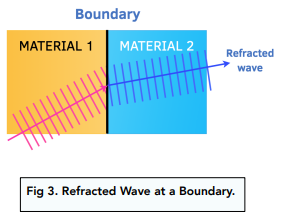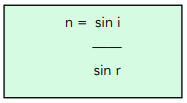Transmission: Refraction (GCSE Physics)
Transmission: Refraction
Refraction
Transmission can lead to refraction. As a wave is transmitted from one material to the other, it can be refracted. Refraction is when a wave changes direction as it crosses a boundary. This means that the wave will enter the material in one direction and leave the material in another direction.

If a wave crosses the boundary at the normal, the wave will not change direction.
Dispersion of Light
- Light is refracted when entering a triangular prism. As white light passes into a triangular glass prism from the air, the light is refracted as it is entering a different medium of a different density.
- Light is refracted when exiting a triangular prism. Similarly, it will be refracted again as it leaves the prism. The different colours of the white light have different wavelengths of light, meaning that there are different angles of refraction.
- The process of dispersion occurs. Through the different angles of refraction, the white light is split into the seven colours of the rainbow by dispersion. As we mentioned before, red has the highest wavelength so is refracted the least. Violet has the lowest wavelength so is refracted the most. We can describe each colour of light as monochromatic.
Refractive Index
The refractive index is a quantity used to identify the point to which light is refracted when it enters another medium.
We can use the following equation:

Where:
- refractive index, n
- angle of incidence, i
- angle of refraction, r
The higher the refractive index, the slower the speed of light in that particular medium.
For example, air has a refractive index of 1.0 whereas glass has a refractive index of 1.5. This means that light travels faster in air compared to glass.





Still got a question? Leave a comment
Leave a comment